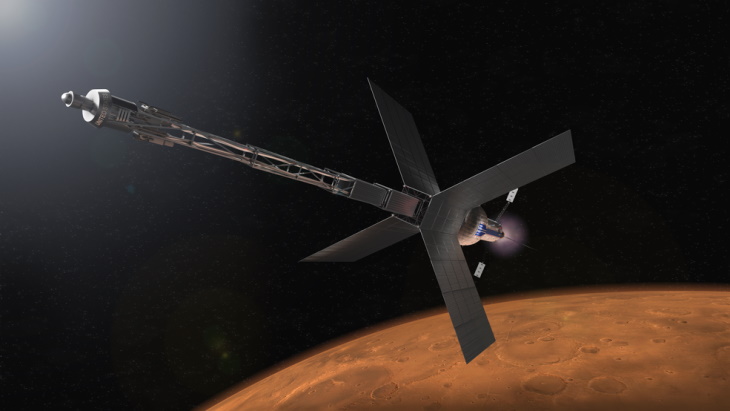Future space missions could have new options opened up by nuclear technology, experts attending an International Atomic Energy Agency event have said.

Illustration of a Mars transit habitat and nuclear propulsion system (Image: NASA)
"Nuclear technology has long played a vital role in prominent space missions, but future missions could rely on nuclear-powered systems for a much broader spectrum of applications - our pathway to the stars runs through the atom," said Mikhail Chudakov, IAEA deputy director general.
He was speaking at the IAEA virtual event - Atoms for Space: Nuclear Systems for Space Exploration - attended by 500 people from 66 countries.
"Crewed interplanetary missions of the future will almost certainly require propulsion systems with performance levels greatly exceeding that of today’s best chemical engines," said William Emrich, former lead project engineer at NASA.
Hui Du of the Beijing Institute of Spacecraft System Engineering, citing a China Academy of Space Technology study, said: "For space missions that need high electric power output, such as a human Mars mission or space ferries, a fission reactor-based power system can be a very competitive choice."
What are the nuclear power options?
One option is nuclear thermal propulsion (NTP), which is where a nuclear fission reactor heats up a liquid propellant, like hydrogen, converting it into a gas which expands through a nozzle to provide thrust and propel a spacecraft. Compared with traditional chemical rockets this could cut travel time to Mars by up to 25%.
Another option is nuclear electric propulsion (NEP) where the reactor’s thermal energy is converted into electrical energy. This method's thrust is lower but continuous and with far greater fuel efficiency it has higher speeds and could cut 60% off the Mars travel time of the traditional chemical rockets.
Research work is also on-going into possible future nuclear fusion rockets which would have a direct fusion drive (DFD) which would directly convert the energy of the charged particles produced in the fusion reactions into propulsion.
Stephanie Thomas, vice president of Princeton Satellite Systems, who are developing a fusion rocket concept, said: "A DFD can produce specific power several orders of magnitude higher than other systems, reducing trip times and increasing payloads, thus enabling us to reach deep space destinations much faster."
What about other uses of nuclear power in space?
In addition to providing thrust for rockets, there is also the need for electrical power on board and nuclear reactors could also be used to provide astronauts with power for extended exploratory missions or long-term communities on other planets.
"NASA’s priority focus remains on designing, building and demonstrating a low-enriched uranium fission surface power system that has broad applications for the lunar surface initiative as well as our eventual mission to Mars with humans, scalable to power levels above 100 kWe, and has the potential to advance NEP system needs," said Anthony Calomino, space nuclear technology portfolio manager at NASA.
"Use of nuclear fission reactors, carrying out continuous chain reactions for many years, is inevitable both for space propulsion and for extraterrestrial surface power," said Vivek Lall, chief executive of General Atomics Global Corporation.
The United Nations has also been considering safety issues
The issue of nuclear technology in space, and the likely use for a variety of purposes and possibly by commercial entities as well as nation states, were issues considered by a meeting of the United Nations Office for Outer Space Affairs scientific and technical subcommittee.
A working paper to the Committee on the Peaceful Uses of Outer Space, prepared by the UK and European Space Agency, notes that since 2010 the sub-committee’s working group had been successful "in promoting the safe use of nuclear power source applications in outer space among States interested in the use of such applications".
But it adds that "the international space sector is evolving … private commercial entities are interested in the use of space nuclear power sources and are starting to propose and engage in the development and use of space nuclear power sources".
"The potential future use of nuclear reactors in the frame of long-term human installations raises a number of new safety-related questions."
It proposes an international forum to "gather and exchange information on plans and projects to develop and use space nuclear power sources by new actors, including commercial entities."
In a draft report published after a meeting earlier this month, the subcommittee also adds that "the view was expressed that it was the responsibility of States to ensure that the use of nuclear power sources in outer space was strictly for peaceful purposes, avoiding at all costs the placement in Earth orbit of any object carrying nuclear weapons or any other type of weapon of mass destruction, as well as avoiding at all costs the placement of such weapons on celestial bodies and the placement of weapons in outer space in any other form."
It added: "The subcommittee welcomed the fact that some States and an international intergovernmental organisation were developing, or considering developing, legal and regulatory instruments on the safe use of nuclear power sources in outer space, taking into account the content and requirements of the Principles Relevant to the Use of Nuclear Power Sources in Outer Space and of the Safety Framework for Nuclear Power Source Applications in Outer Space, which was developed jointly by the Subcommittee and the International Atomic Energy Agency."
Researched and written by World Nuclear News